Minnie The Moocher
Minnie The Moocher is the greatest hit of Cab Calloway. The song was recorded in 1931 and, although it was the time of the big crisis in the USA, it turned out to be a great success. The sales exceeded one million records.
The song wasn’t Cab Calloway original idea. He used a song from 1927 called 'Willie the Weeper', which author and performer was Frankie 'Half-Pint' Jaxon.
Minnie The Moocher
Frankie 'Half Pint' Jaxon (1895 – 1944) was a black singer, stage designer and comedian taking part in vaudevilles. He was quite popular in 1920s and 1930s. The nickname “Half Pint” originated from his short stature. Jaxon had a high-pitched, almost female voice and for this reason he often played female roles. He gave concerts with the best orchestras and jazz bands. In 1929 he appeared in a film Black and Tan Fantasy, in which he preformed with Duke Ellington’s orchestra. At present, however, he is most famous for being Cab Calloway’s inspiration for Minie The Moocher.
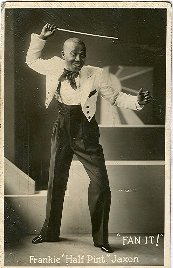
Frankie 'Half Pint' Jaxon
Calloway was born in Rochester, New York, in 1907 in a middle class family. His father was a lawyer and his mother gave organ lessons. Noticing their son’s musical talent, they enrolled him on singing lessons. Against their wishes, Cab quickly became interested in jazz. He was growing up in Baltimore and in the evenings he would often sneak out of the house to perform with local bands. He continued with the singing lessons and also obtained general education. In 1930 he graduated from university. Together with his sister, Blanche, he started a career, starring in medicine show titled Plantation Days. Blanche Calloway became a well-known jazz singer and she was more famous than her brother.
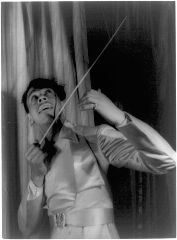
Cab Calloway, 1933
Cab Calloway started to play percussion and sing in well-known clubs in New York. He met Louis Armstrong, who encouraged him to sing 'scat' style. Calloway remembered this advice. He set up his own orchestra, which quickly conquered the town. The success appeared instantly – at the time of the first performance in the legendary Cotton Club.
Cotton Club was the most exclusive club in New York, especially in the prohibition era. It was situated in Harlem, which was at the time centre of music and entertainment. It was established by Jack Johnson, a heavy weight boxing champion in 1908 -15. He was the first black boxer, who won the title of the world champion. According to Ken Burns, a director documentalist, in the early 20th century Johnson was the most famous and apprised black person in the world.
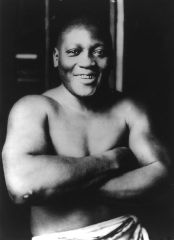
Jack Johnson
Stars like Bessie Smith, Duke Ellington, Count Basie, The Nicholas Brothers, Ella Fitzgerald, Louis Armstrong, Billie Holiday i Ethel Waters played in Cotton Club. On Sundays famous showmen appeared on stage. They were, among others, Jimmy Durante, George Gershwin, Al Jolson, Mae West, Irving Berlin, Eddie Cantor, Moss Hart. Many guests were officials. The Mayor of New York regularly visited Cotton Club. In general the black population was banned from entering the club. Only celebrities were an exception. The club was closed down in 1940.
In Cotton Club Duke Ellington’s Orchestra ran the show. Ellington, however, went on a long tour around the country. Cab Calloway was invited to take his place. Calloway prepared a show named Brown Sugar. It was received very well by the audience and this open for Calloway the way to fame. His performances in the club were transmitted live on radio station NBC for two weeks.
Minnie The Moocher from 1931 guaranteed quick fame for Cab Calloway. This fame was also shared by the musicians, who played with him: Dizzy Gillespie and Adolphus 'Doc' Cheatham, who played trumpet, Ben Webster and Leon 'Chu' Berry, who played saxophone, guitarist from New Orlean Danny Barker and bass guitarist Milt Histon.
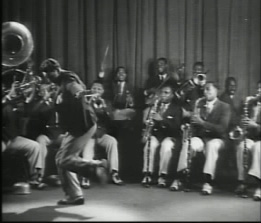
Cab Calloway and His Orchestra
During one of the early performances of Minnie the Moocher Cab Calloway forgot the lyrics of the chorus, so they improvised the phrase 'hi de hi de hi de ho'. This chorus later became one of the most popular fragments of jazz vocalism. Calloway applied scat. In scat style or technique the singer uses random words or syllables. It allowed jazz singers to improvise like instrumentalists. It is not easy and not everyone can sing scat. Ella Fitzgerald mastered the technique.
Minnie The Moocher was the main point in Cab Calloway’s repertoire. During his performances in Cotton Club he already engaged the audience in the fun in the form of call and response, which meant that the audience sang back. The guests in the club always had a great time with 'Hi De Hi De Hi De Hi', as their attempts usually sounded quite false in the beginning.
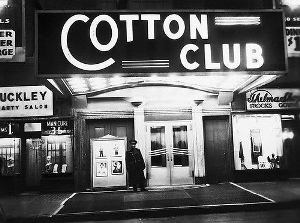
Cotton Club
As early as 1932 Minnie the Moocher was featured in a film. Calloway sang in a cartoon about the adventures of Betty Boop and Bimbo. In the film 'Hi De Ho' from 1947 Jeni Le Gon played the role of Minnie and Calloway starred as himself. In 1955 a show called Rhythm and Blues Revue, in which Calloway sang Minnie the Moocher, was filmed in Apollo Theatre. Much later, when he was 73 years old in 1980, he performed this song in The Blues Brothers.
Also in 1980 Minnie the Moocher was presented by a band The Mystic Knights Of The Oingo Boingo in a cult film The Forbidden Zone. In 1984 Larry Marshall starred as Calloway in Coppola’s The Cotton Club.
The song keeps appearing in TV programs and cartoons.
Minnie The Moocher has many different covers. It is mainly sang and played by jazz musicians, but sometimes it is taken on by artists from different genres.. In 1999 it entered the Grammy Hall of Fame.
Minnie The Moocher, Blues Brothers version
Hey folks here's the story 'bout Minnie the Moocher
She was a lowdown hoocie coocher
She was the roughest toughest frail
But Minnie had a heart as big as a whale
Hidehidehidehi (Hidehidehidehi)
Hodehodehodeho (Hodehodehodeho)
Hedehedehedehe (Hedehedehedehe)
Hidehidehideho (Hidehidehideho)
She messed around with a bloke named Smokie
She loved him though he was cokey
He took her down to Chinatown
and showed her how to kick the gong around
Hidehidehidehi (Hidehidehidehi) Whoah (Whoah)
Hedehedehedehe (Hedehedehedehe)
A hidehidehideho (Hidehidehideho)
She had a dream about the king of Sweden
He gave her things that she was needin'
He gave her a home built of gold and steel
A diamond car with platinum wheels
A hidehidehidehidehidehidehi (Hidehidehidehidehidehidehi)
Hodehodehodehodehodehodeho (Hodehodehodehodehodehodeho)
Scurlivouscurlivouscurlivourlivourlivu (Scurlivouscurlivouscurlivourlivourlivu)
SeteteteteRaburlutuSceteteRaburlututoy (SeteteteteRaburlutuSceteteRaburlututoy)
He gave her his townhouse and his racing horses
Each meal she ate was a dozen courses
Had a million dollars worth of nickels and dimes
She sat around and counted them all a million times
Hidehidehidehi (Hidehidehidehi)
Hodehodehodeho (Hodehodehodeho)
Hedehedehedehe (Hedehedehedehe)
Hidehidehideho (Hidehidehideho)
Poor Min, poor Min, poor Minnie
Last Updated (Saturday, 14 March 2015 15:26)








